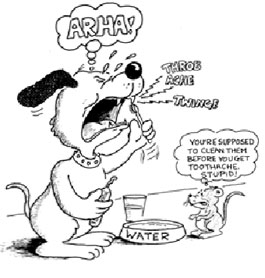
February is National Pet Dental Health Month. The purpose of Pet Dental Health Month is to raise the awareness that pets need dental care. The American Veterinary Medical Association estimates that more than 80 percent of dogs and 70 percent of cats have oral disease by the time they are 3 years old.
Although our pet dogs and cats are highly domesticated, their ancestors evolved to hide symptoms of weakness or injury in order to survive in the wild, and modern pets have retained this characteristic. Thus, your pet may be suffering in painful silence from a hidden dental condition such as a tooth root abscess, a broken tooth, dental decay, or inflammation/infection of the structures surrounding the teeth (periodontitis). Often the only thing that you might notice is that your dog no longer plays with chew toys or that your cat paws at her mouth more often. Once a tooth root becomes infected, it will require either a root canal treatment or an extraction.
Dental plaque and tartar are the main culprits that cause the development of a dental infection. When plaque and tartar are first deposited on the teeth, they cause gingivitis or inflammation of the gums; over time, bacteria and other organisms invade the inflamed tissues, causing an infection. Left untreated, they will spread, causing stomatitis (general infection of the mucous membranes of the mouth) or periodontitis (an infection of the ligaments, soft tissues and bones that anchor the teeth in place). Ultimately, oral disease will lead to tooth loss.
Fractured teeth can also set the stage for development of a tooth infection. The most common causes of tooth fractures are playing catch with hard items and chewing on objects such as bones or rocks. Teeth may break on the cusp or tip, on the side (called a slab fracture), or along the root. Cusp fractures are usually fairly visible, but both slab and root fractures may go unnoticed to a pet owner until an abscess develops.
The third major cause of tooth infections in pets is dental decay. In dogs, this is relatively uncommon, estimated at less than 10% of all dental problems. However, in cats, enamel decay or erosion is a very common problem known by several different names including “oral resorptive lesions”, “neck lesions”, “cervical line erosions”, and other terms. When the protective enamel of the tooth is lost, bacteria will quickly infect the tooth and surrounding bone. The teeth ultimately become brittle and parts of them snap off, leaving behind fragments that cause further problems.
Dental disease is perhaps one of the most under-recognized serious health risks for our pets, in part because it is a ‘silent’ disease. Animals cannot tell us if their teeth hurt. Therefore, it is up to you to “flip the lip” and look at your pet’s teeth often, to brush those teeth, and to visit your veterinarian at least once per year so that he or she can recommend the appropriate treatment to keep your pet’s pearly whites looking and feeling good for life. Although February is National Pet Dental Health Month, you should remember that your pets deserve dental care every month of the year.

